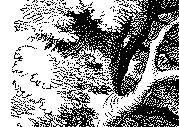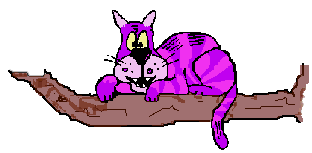Cheshire cells
 |
 |
|
Cheshire cells |
|
|||||||||
From AMoRe documentation:
"The Cheshire cell is the minimum volume which will allow a unique solution. For the first molecule it will be the cell which covers a volume from one possible origin to the next - you can usually see it by inspection of International Tables, e.g.: For P212121, the Cheshire cell is 0-0.5,0-0.5,0-0.5. For P21 the Cheshire cell is 0-0.5,any y,0-0.5. If you are searching for the NMOLth molecule of a set, the Cheshire cell will now be the whole primitive volume. You have assigned the origin by choosing the position of the first molecule, and the other molecules will have to be positioned relative to that choice."
Ian Tickle wrote:
Basically the Cheshire group is the space group of the crystal when its material contents are removed leaving only the symmetry elements, like the smile that was left when the Cheshire Cat disappeared. (In case you're not aware of the connection between Alice in Wonderland and CCP4, Charles Lutwidge Dodgson, alias Lewis Carroll, was born in Daresbury which is located in the English county of Cheshire).
The higher the space group symmetry, the lower is the symmetry of the Cheshire group, e.g. for space group P1 the Cheshire group consists of a single point (i.e. all points in the space are equivalent), which means that in P1 the translation function for 1 mol./a.u. is already solved before you start! Conversely, for primitive cubic space groups, the Cheshire cell has much lower symmetry, which means you have to search half the unit cell, even with 1 mol./a.u.
In between these extremes there are all the other space groups. For further details look in my documentation for the TFFC program (you might even try using the program!).
From Molecular Replacement - Protein Crystallography Course at Structural Medicine, Cambridge, UK:
Search volumes
In conducting a translation search, you might think that it is necessary to search over the asymmetric unit. In fact, this is not true. The origin of a crystal is, to a certain extent, arbitrary. In P1, for instance, any point can be an origin, so it is not necessary to carry out a translation search. In higher symmetry space groups, the mathematical form of the symmetry operations restricts the possible origins, but there are still different valid choices. So all that needs to be searched is the unique volume relative to any allowed choice of origin. For an orthorhombic space group, the two-fold axes (rotational or screw) repeat every half unit cell in all three directions, so there are eight possible choices of origin. In contrast, the asymmetric unit for (say) P222 occupies a quarter of the unit cell.
This unique volume relative to a possible choice of origin is called the Cheshire cell. It was probably named by a fan of Lewis Carroll, because the Cheshire cell is what is left when you take away the contents of the unit cell and leave only the symmetry operators (read "smile").
Mind you, you are only limited to the Cheshire cell in searching for the first molecule, when there is more than one molecule in the asymmetric unit. Placing the first molecule fixes the origin, so subsequent searches for additional molecules have to cover the whole unit cell. (To be precise, the unique volume relative to a lattice point; the necessary search volume is reduced in a centered lattice.)
A table of the Cheshire cells for all 230 space groups is available in Hirshfeld (1968) Acta Cryst A24 301-311. It is reproduced below.
Z x is a primitive cell with x axes vanishing (or x axes not important for symmetry). eb means "no b" (or: b axis not important).
| Cheshire group and unit cell | Space groups | |
|---|---|---|
| P_ P1 |
1/2a * 1/2b * 1/2c | P_ P1 |
| Z 31 | ea * eb * ec | P1 |
| P2/m | 1/2a * 1/2b * 1/2c | P2/m, P21/m, C2/m, P2/c, C2/c |
| Z 12/m | 1/2a * eb * 1/2c | P2, P21, C2 |
| Z 22/m | ea * 1/2b * ec | Pm, Pc, Cm, Cc |
| Pmmm | 1/2a * 1/2b * 1/2c | P222, P2221, P21212, P212121, C2221, C222, I222, I212121, Pmmm, Pnnn, Pccm, Pban, Pmma, Pnna, Pmna, Pcca, Pbam, Pccn, Pbcm, Pnnm, Pmmn, Pbcn, Pbca, Pnma, Cmcm, Cmca, Cmmm, Cccm, Cmma, Ccca, Fmmm, Immm, Ibam, Ibca, Imma |
| Pnnn | 1/2a * 1/2b * 1/2c | Fddd |
| Immm | 1/2a * 1/2b * 1/2c | F222 |
| Z 1mmm | 1/2a * 1/2b * ec | Pmm2, Pmc21, Pcc2, Pma2, Pca21, Pnc2, Pmn21, Pba2, Pna21, Pnn2, Cmm2, Cmc21, Ccc2, Amm2, Abm2, Ama2, Aba2, Fmm2, Imm2, Iba2, Ima2 |
| Z 1ban | 1/2a * 1/2b * ec | Fdd2 |
| P4222 | 1/2(a-b) * 1/2(a+b) * 1/2c | P4122, P41212, P4322, P43212 |
| Z 1422 | 1/2(a-b) * 1/2(a+b) * ec | P41, P43 |
| P4/mmm P4/mmm |
1/2(a-b) * 1/2(a+b) * 1/2c 1/2(a-b) * 1/2(a+b) * 1/2c |
P_ P4, P4/m, P42/m, P4/n, P42/n, I4/m, P422, P4212, P4222, P42212, I422, P_2m, P_2c, P_21m, P_21c, P_m2, P_c2, P_b2, P_n2, I_2m, P42m, P42c, P421m, P421c, P4m2, P4c2, P4b2, P4n2, I42m, P4/mmm, P4/mcc, P4/nbm, P4/nnc, P4/mbm, P4/mnc, P4/nmm, P4/ncc, P42/mmc, P42/mcm, P42/nbc, P42/nnm, P42/mbc, P42/mnm, P42/nmc, P42/ncm, I4/mmm, I4/mcm |
| P42/nnm | 1/2(a-b) * 1/2(a+b) * 1/2c | I41/a, I4122, I42d, I41/amd, I41/acd |
| I4/mmmI4/mmm | 1/2(a-b) * 1/2(a+b) * 1/2c | I_,
I_m2,
I_c2 I4, I4m2, I4c2 |
| Z 14/mmm | 1/2(a-b) * 1/2(a+b) * ec | P4, P42, I4, P4mm, P4bm, P42cm, P42nm, P4cc, P4nc, P42mc, P42bc, I4mm, I4cm |
| Z 14/nbm | 1/2(a-b) * 1/2(a+b) * ec | I41, I41md, I41cd |
| R_m R3m |
-b * (a+b) * 1/2c | R_,
R32, R_m,
R_c R3, R32, R3m, R3c |
| Z 131m | 1/3(a-b) * 1/3(a+2b) * ec | R3, R3m, R3c |
| P6222 | a * b * 1/2c | P3121, P6122, P6422 |
| 1/3 (a-b) * 1/3(a+2b) * 1/2c | P3112 | |
| P6422 | a * b * 1/2c | P3221, P6522, P6222 |
| 1/3(a-b) * 1/3(a+2b) * 1/2c | P3212 | |
| Z 1622 | a * b * ec | P61, P65, P62, P64 |
| 1/3(a-b) * 1/3(a+2b) * ec | P31, P32 | |
| P6/mmm P6/mmm |
a * b * 1/2c a * b * 1/2c |
P_,
P321,
P_1m,
P_1c,
P_m1,
P_c1, P3, P321, P31m, P31c, P3m1, P3c1, P6/m, P63/m, P622, P6322, P62m, P62c, P6/mmm, P6/mcc, P63/mcm, P63/mmc |
| 1/3(a-b) * 1/3(a+2b) * 1/2c | P312, P_,
P_m2,
P_c2 P312, P6, P6m2, P6c2 |
|
| Z 16/mmm | a * b * ec | P31m, P31c, P6, P63, P6mm, P6cc, P63cm, P63mc |
| 1/3(a-b) * 1/3(a+2b) * 1/2c | P3, P3m1, P3c1 | |
| Ia3 | a * b * c | Pa3 |
| I4132 | a * b * c | P4332, P4132 |
| Pm3m | 1/2a * 1/2b * 1/2c | Fm3, F432, Fm3m, Fm3c |
| Pn3m | 1/2a * 1/2b * 1/2c | Fd3, F4132, Fd3m, Fd3c |
| Im3m Im3m |
a * b * c a * b * c |
P23, I23, Pm3, Pn3, Im3, P432, P4232, I432,
P_3m,
I_3m,
P_3n P23, I23, Pm3, Pn3, Im3, P432, P4232, I432, P43m, I43m, P43n, Pm3m, Pn3n, Pm3n, Pn3m, Im3m |
| 1/2a * 1/2b * 1/2c 1/2a * 1/2b * 1/2c |
F23, F_3m, F_3c F23, F43m, F43c |
|
| Ia3d Ia3d |
a * b * c a * b * c |
P213, I213, Ia3,
I4132, I_3d P213, I213, Ia3, I4132, I43d, Ia3d |
 From Cheshire Cat - J. Hoffman |
 From Purr-fection |